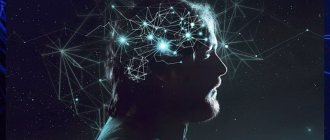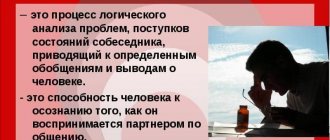What did ancient philosophers say about her?
Scientists of the ancient East and West approached the study of what human activity is from both materialistic and idealistic points of view.
You may be interested in: Formation and development of general educational skills in schoolchildren
Socrates (470-399 BC, Ancient Greece) explained it by the state of the soul, which he considered its mental property, the focus of moral ideas. These ideas are formed as a result of a person’s learning what is good and evil, and the types of activity and the nature of his actions depend precisely on this knowledge. Socrates' slogan “know thyself” should be understood as a call to analyze behavior and attitudes towards it, and not to analyze one’s own emotions and experiences.
You may be interested in:What is litmus and how is it useful?
Aristotle (384-322 BC), studying what mental activity is, called exercise in moral actions as a condition for its increase. Simple knowledge of good and evil does not make a person the owner of such qualities as, for example, virtue and prudence - constant training and exercise in them make him such.
The teaching of the Stoics arose in Athens in the 4th century BC. e. His followers believed that increasing the activity of the psyche is inaccessible to ordinary people, its guidance is the lot of only true sages, whose mind is dispassionate and does not allow emotional experiences. Any emotional upheaval deprives a person of internal freedom and interferes with the fulfillment of his duty.
Epicurus (341-270 BC, Ancient Greece), on the contrary, considered renunciation of social activity to be true happiness. He saw it in the satisfaction of simple needs. The will, mind, and mental activity of a person must be directed to training in self-restraint from unattainable pleasures, otherwise suffering from their unattainability is inevitable.
Begalieva S.B.
Head of Department, Kazakh National Pedagogical University named after Abay, Doctor of Pedagogical Sciences, Professor, Kazakhstan, Almaty
ABOUT ACTIVITY AS AN INTEGRAL CHARACTERISTIC OF PERSONALITY
Different psychological schools interpret the concept of human activity differently. In some of them, activity is defined as a property of an individual, a subject, in others - as a characteristic of a person and his life activity.
In order to most fully characterize the category of activity, let us turn to psychological dictionaries and analysis of a number of sources on this issue.
“Personal activity is a person’s ability to make socially significant transformations in the world based on the appropriation of the wealth of material and spiritual culture, manifested in creativity, acts of will, and communication. Personal activity is an integral characteristic... which influences a person’s views and beliefs” [1, p. 14]. This definition states that the activity of a person is its integral characteristic. This means that it includes motivational incentives, interests, human abilities, volitional qualities, i.e. the whole person as a whole.
In this definition, we are attracted to the idea that activity leads to creative self-expression of the individual.
In psychological dictionaries, the content of a person’s activity is considered in many ways: supra-situational, search, and excess types of activity are noted.
Trans-situational activity is the ability of the subject to rise above the level of the requirements of the situation, to set goals that are redundant, from the point of view of the original task. Through supra-situational activity, the subject overcomes external and internal “barriers” of activity. Trans-situational activity is important in creative, intellectual activity, etc.
Search activity is behavior aimed at changing a situation (or attitude towards it) in the absence of a specific forecast of its results, but with a constant analysis of the degree of its effectiveness.
Search efficiency is an important component in the processes of planning and solving a problem.
Excessive activity is one of the forms of supra-situational activity, expressed in the desire of an individual or group to exceed the normative requirements officially imposed by society for a particular type of activity [2, p. 15].
Characteristics of the category of personality activity as interpreted by some scientists
| № | Authors | Characteristics of the concept of “personal activity” |
| Russian psychology | ||
| 1. | V.A. Petrovsky | Personality is the subject of activity. Activity is an active state, determined internally, in terms of its relationship to the world, realized externally, in the processes of behavior. Activity as an active state of a person is integrity that links together the processes occurring in the internal plane (the formation of motives, goals, patterns of action) and in the plane of behavior (activity, action, operations). |
| 2. | K.A. Osnitsky | Activity is a manifestation of subjectivity, expressed in the expression of will in the process of life based on accumulated experience, personally significant goals, values and the formation of the image of the world. |
| 3. | IN. Tatenko | Subjective mental activity is the only determinant of self-development of the inner world. |
| 4. | M.V. Bodunov | Activity is an essential characteristic, an “integral” parameter of personality. The author identifies a qualitative, meaningful activity, determined by a complex of operating motives, attitudes, interests and motivations that determine the performance of certain actions, as well as a quantitative, procedural side, characterizing the activity performed according to such formal parameters as pace, intensity, level and time distribution . |
| 5. | B.M. Teplov | Activity as a general component of a naturally determined property of the nervous system, which affects the interaction of temperament and abilities. |
| 6. | N.S. Leites | Activity is the most important internal factor in the success of an activity. Activity depends on the activation of the brain. |
| 7. | A.I. Krupnov | Activity is a special state, ... a relatively stable property of a person, manifested in the level of intensity of the implementation of behavior, activity and its result. Proves the relationship between internal and external factors on the manifestation of activity. The driving forces of human activity are the contradictions that arise in the process of interaction of internal and external factors during the implementation of a particular activity. Activity includes qualitative and quantitative characteristics. |
| 8. | K.A. Abulkhanov- Slavskaya | Considering the activity of a person as a unity of manifestation of external and internal factors in a person’s life, the author presents activity as a holistic way of modeling, structuring and implementing personal activity, communication and behavior, in which it acquires the quality of a system; activity as a way of expressing needs in the motivational sphere and its satisfaction. Social activity acts as a way of relating oneself to other people, determining one’s position, and self-determination. |
| In foreign Western psychology | ||
| 9. | H. Heckhausen | By activity we mean the reactions, actions, and behavior of the subject. Activity – external actions of the subject, internal mental processes. |
| 10. | Early behaviorism | Activity is the totality of the body’s reaction to the external environment (stimulus - response - S - R). |
| 11. | Neobehaviorism: E. Tolman, K. Hall, J. Brown, T. Kelly et al. | Activity (behavior) is based on the needs of the subject. |
| 12. | B. Skinner | The basis of behavior (activity), in addition to the initial needs, must take into account the consequences (success or failure of learning). |
| 13. | E. Tolman, K. Levin, J. Rotter, L. Festinger and others. | Activity is the state of the subject’s needs, his abilities, persistence in achieving a goal, etc. |
| 14. | Z. Freud | The subject's activity is based on instincts and drives. The predominant drives, according to Freud, are sexual, which can be manifested in sublimation (activity in another field of activity). |
| 15. | K. Rogers, A. Maslow, G. Allport | The main source of behavior and its activity is human needs. |
Analysis of the above points of view of Russian scientists on personality activity allows us to conclude that there is much in common in the characteristics of this concept. All authors understand human activity as a stable property that allows him to successfully perform various types of social and personal activities, promotes self-determination and self-affirmation.
Activity is an integral characteristic of the personality in which the motivational-need, content and procedural spheres of the personality interact.
As sources of personality activity, most scientists identify the unity of internal (needs, interests, abilities of intellectual potential) and external (needs of the social environment, society in a broad sense) factors.
Our attention is drawn to the point of view of K.A. Abulkhanova-Slavskaya about activity as a holistic way of designing and implementing personal activity, i.e. activity is understood by her as a system.
Unlike Russian scientists, the authors of Western psychology replace the term “activity” with the concepts of “behavior” and “action”. Their attention, as will be shown below, is largely focused not on the essential characteristics of an individual’s activity, but on the sources of its manifestation.
The described characteristics of the essence of personality activity are complemented by neurophysiological as well as social aspects.
In differential psychophysiology, the relationship between human neurophysiological characteristics (properties of the nervous system, integral EEG parameters, degree of brain activity, etc.) and mental activity (intensity, energy, speed, etc.) is studied (N.S. Leites, A.I. Krupnov , V.M. Rusalov, B.M. Teplov, etc.).
Personal activity, in addition to its physiological nature, has a social essence, since man is a social being. Activity at the personal level is manifested in accordance with learned norms, rules of behavior in society, value orientations, personality orientation, and is also expressed in the ability to mobilize one’s internal potential and evaluate current situations. Thus, the social nature of an individual’s activity is revealed in connection with the most important events in his life: choice of profession, social circle, religion, starting a family, etc.
Emphasizing the social nature of individual activity, K.A. Abulkhanova-Slavskaya believes that in certain situations a person can rise above these situations, overcome obstacles and reach a new level of activity, which undoubtedly leads to self-realization and self-affirmation. At the same time, contradictions are the sources of individual socialization. Internal contradictions of the individual, notes K.A. Abulkhanova-Slavskaya, are derived from public ones. Personal development in activity occurs through the resolution of contradictions. In relation to the activity of a person, the contradictions that he encounters can be different. Some of them cannot be resolved specifically by one person; they can be resolved by a group of people or even society as a whole (K.A. Abulkhanova-Slavskaya). This provision is essential in the creative activity of a teacher: some pedagogical problems can be solved by one teacher, others - in collaboration with colleagues, others - with the participation of administrative bodies and services, and the state in general.
The social nature of mental activity was pointed out by L.S. Vygotsky. The fundamental principles he developed (the determinism of assimilation during ontogenetic development of certain forms of social experience, the unity of consciousness and activity) allowed him to take a fresh look at the problem of activity. The principle of determinism, according to L.S. Vygotsky, lies in the refraction of the external through the internal. The objective world, social relations and other external factors, physiological, mental, are internal sources of activity.
The most important problem in understanding the nature of personality activity is the relationship and distinction between the general biological and mental aspects of its development.
Biological activity is based on the body's response to external and internal stimuli. Proof of this is the genetic patterns of behavior, in particular the genetics of the conditioned reflex.
When considering human biological activity, the above-mentioned scientists note that it is necessary to take into account his interaction with the outside world. In this case, response actions conventionally go through three stages:
– brain activation, which is carried out by the interaction of signals from the outside world and the body itself;
– processing of received information by the brain;
– choosing the most appropriate behavior taking into account the situation and past experience.
At the same time, the activity of the central nervous system and human behavioral acts are carried out with the participation of memory, thinking and other mental processes and abilities.
Consequently, the level of a person’s mental activity depends on three interrelated factors:
– level of consciousness and brain activity;
– the level of innate needs and acquired during life;
– effectiveness of emotions and feelings.
The relationship between biological and social factors in the development of mental processes, including human activity, was experimentally proven by A.R. Luria [2]. He showed that the external conditions of social life, the socio-historical forms of human existence determine the nature and psychological structure of his cognitive processes, which also determine the level of activity in various spheres of life. He believed that a person’s intellectual potential is formed under the influence of learning, i.e. social experience. A.R. Luria did not deny the role of psychophysiological foundations in the manifestation of activity (for example, conditioned reflexes), but believed that they are not “directly superimposed on the morphological outline,” but are connected to complex systemic formations.
Speaking about the role of the social factor in the formation of human activity, we consider it necessary to dwell on the concept of V.A. Petrovsky about personalization. According to this concept, communication and the active principle are of great importance in the socialization of the individual. The same point of view is shared by D.B. Epiphany. Along with the internal determination of the subject’s activity as its source, she identifies another source – the subject’s relationship with the environment, the manifestation of activity in actions, activities, and behavior. The level of activity of an individual depends not only on the perception of the world, but also on accumulated social experience.
Thus, an analysis of the points of view on the essence of personality activity of Russian psychologists leads us to the conclusion that activity is considered by them either as a property of the subject, or as a special state of it, an “integral characteristic.” Internal and external factors are identified as sources of formation of personality activity. The driving forces behind the development of a subject's activity are contradictions.
Literature
1 Psychological Dictionary / Under general. ed. A.V. Petrovsky, M.G. Yaroshevsky. – 2nd ed., rev. and additional – M.: Politizdat, 1990. – 494 p.
2. Luria A. R. The human brain and mental processes. - M.: Pedagogy, 1970. - 496 p.
Does society need active people?
You might be interested in: Development of a truncated cone. Area formula and example of solving the problem
Stimulating employee business entrepreneurship is one of the goals of modern management. Its development leads to a significant increase in labor productivity and the development of a culture of industrial and non-productive relations.
In psychology, activity is defined as the activity of an individual aimed at the environment in order to satisfy his own needs. Its owner is considered to be a person with such personal qualities as:
- focus,
- awareness of the choice of ways and means to achieve goals,
- the ability to analyze the results of one’s actions and adjust them taking into account the current situation.
Such an individual, satisfying his own material, social, ethical, artistic needs, strives to transform the environment, meaningfully improves tools, and participates in solving creative labor and social problems. His personality improves because he wants to know more, learn a lot. That is, it can be argued with good reason that the initiative of members of society contributes to its comprehensive progress.
Concept
What is social activity?
In a general sense, activity is any action aimed at changing the surrounding world, both material and spiritual.
The object of activity can be any object, process or idea, and its result is the transformation of this object or the creation of new objects.
For example, professional activity in any craft is the creation of a complete object from a group of materials using the tools, means and knowledge that the master possesses.
The concept of social activity is somewhat deeper. It takes into account the relationship of this process with society, indicates the significance of human activity in the system of foundations and values of a certain group of people.
The following goals of social activity are distinguished:
- satisfying a person’s vital needs, obtaining material or ideal (non-material) values,
- construction of a subjective image of the surrounding reality, stimulation of thinking,
- transformation of reality within the entire society or its individual group,
- psychological development and self-realization of a person.
Ultimately, for every mentality, character and way of thinking, one of the goals becomes the main one, and the others only complement it.
However, these goals are closely interrelated; by excluding one from the overall system, a person destroys the rest.
His actions take on a destructive nature, resulting in the cessation of development or degradation of thinking, abilities and skills.
For example, artists, deprived of the opportunity to develop creatively, experience difficult internal experiences, apathy and loss of strength, which prevents them from achieving other social goals.
Activity levels
The more attractive a person’s goal is, the more energy he spends to achieve it. The highest level of activity is observed in people with a harmonious personality type: they have highly developed both responsibility for the task and the desire to obtain the greatest internal satisfaction from its results.
Individuals of the productive type also have high results of actions, however, they achieve them because of their passion for their ideas, and not because of a high level of responsibility.
The reflexive type is distinguished by heightened consciousness and hypercontrol, but these qualities, combined with self-criticism, make him unsure of himself and his initiatives. Therefore, he is ready for their active implementation only with outside moral support.
People of the performing and functional type show lack of independence in achieving the goals set for them. Having taken responsibility, they strictly follow third-party directions and instructions, use ready-made solutions, without using their own initiative.
You will be interested in: Research technology: concept, introduction of new things, project development, goals and objectives
Contemplators can put forward complex business and creative proposals, but in the foreground they put forward the promotion of their own “I”, and not the activity of implementing their ideas. Lack of responsibility and independence, aggressiveness are characteristic features of people of this type.
Thus, what level of activity he has (high, medium or low) depends both on the person’s natural personal qualities (temperament, abilities), and on those brought up in him by his parents and social environment.
Researchers' opinions
The methodological conclusion of V. G. Mordkovich is also interesting. He considers activity as an essential feature of the subject. If someone else’s will is imposed on a person, then he becomes a carrier of activity. In other words, the individual turns from a subject into an object that performs other people's tasks for which he has no need. To designate people of this type, the concept “socially passive” was introduced. At the same time, it is noted that not all needs have a driving influence on activity, but only those whose satisfaction has social significance or affects certain public interests. The structure of the behavioral model in this case depends on the goals pursued by the subject and the preferred levers of influence.
Forms and factors of human activity
At birth, a person is completely dependent on the people around him. But as he grows up and develops, new opportunities appear that support his independent existence as an individual and encourage him to engage in certain types of activities.
Soviet psychologist B. G. Ananyev, in his research, identified such forms of human activity as communication, work and cognition.
In the works of other scientists, these include contemplation, reflection and behavior, managing other people, amateur performances, as well as creative, artistic, cognitive, incentive, practical, combat, sports, information and communication forms.
The reasons or factors of human activity are explained by the need to satisfy a number of needs that guarantee him, firstly, physical survival (food, clothing, housing, protection, reproduction). Secondly, he needs communication and recognition by other members of society, which is a source of intensification of his labor and communication activities. Thirdly, satisfying spiritual needs requires the individual to have his own energetic search for inner freedom, self-promotion in creativity, and actions to change the environment in accordance with his views and needs.
Activity as a result of education
In order to act purposefully, a person must show creativity, strong-willed efforts, communicate with other people - seek advice, study other people’s experiences. But these qualities - a strong will, a non-standard approach to a problem, the ability to communicate, analyze, draw conclusions - are not born with the baby. What is activity? This is the result of proper upbringing.
Its formation in a child is one of the many parental tasks, which is not as simple as it seems at first glance. First of all, adults are required to have a conscious approach to achieving this goal and patience: the development of activity is one of those pedagogical problems that cannot be solved quickly.
Note to parents: how to do this
An active person means active, energetic. Children become like this in families that support a democratic style of relations between them and adults. It presupposes flexibility in relationships: by showing sufficient demands and control, parents respect the child’s opinion and position, develop his independence, initiative, and self-criticism. Possible instructions and meaningful encouragement stimulate increased activity in achieving the goal. What is important is sufficient help, a calm, business-like analysis of both the results of the child’s initiative, as well as mistakes made and successful actions.
An authoritarian parenting style suppresses a child’s activity, since threats of punishment and coercion cause fear of violating an adult’s instructions and making mistakes in their actions.
The liberal style, on the contrary, is undemanding towards children. Maximum freedom with a minimum of restrictions on behavior creates aggressiveness and permissiveness. Such children believe that achieving a goal consists of forcing adults to bring them what they want on a platter, and not in showing intelligence and enterprise themselves.
Manifestations
What are its manifestations? Having analyzed the above, we can come to the conclusion that activity is, first of all, change, transformation. Any social activity is based on four components:
- a person’s attitude to the totality of surrounding objects of the material world,
- a person’s attitude towards other people, the group and society as a whole,
- attitude towards events and phenomena,
attitude towards oneself.
Despite the fact that any change occurs simultaneously in the entire complex of these components, the degree of its influence is not the same.
Thus, activity directed at a material object is called an action, and activity directed at a person, group or society is called an act.
Internal changes, the subject of philosophy and psychology, are expressed in the thoughts and feelings of a particular person.
And only events and phenomena that play the role of an external factor cannot be influenced by a person.
Society as a subject of education of activity
The state is extremely interested in educating active and proactive citizens. That is why any educational institution, the media, among other tasks, set themselves the difficult task of creating activity among the population.
Teachers, psychologists, social workers, cultural workers, public associations, leaders of all ranks act as subjects of the process, the goal of which is to educate a socially responsible citizen. He must have:
- interest in social work,
- organizational qualities,
- diligence and initiative,
- self-criticism and demandingness towards oneself and others,
- willingness to help people.
These qualities guarantee the provision of public order and control over the implementation of laws at the local level, and direct interaction between the population and the authorities.
Activity with a minus sign
Criminal, immoral activities of citizens are not approved by society and are even punishable. What kind of activity a person has, what types, levels and forms he chooses depends on the internal position of the individual. By the actions and how it manifests itself, one can judge many human qualities. The higher the moral values, the more the ways of satisfying needs (“I want” and “I must”) correspond with the rules and norms of human existence (“It is possible” or “It is not possible”). Hence the numerous examples of selfless courage and unparalleled meanness, hard work and shameless theft of other people’s property for the sake of one’s own comfortable existence, uncompromising honesty and large-scale lies in order to become famous.
Antisocial “activity” in the selfish satisfaction of one’s needs is the result of a combination of many circumstances in a person’s personal and public life with his negative internal qualities - greed, vindictiveness, laziness, inability to control one’s actions and emotions.











